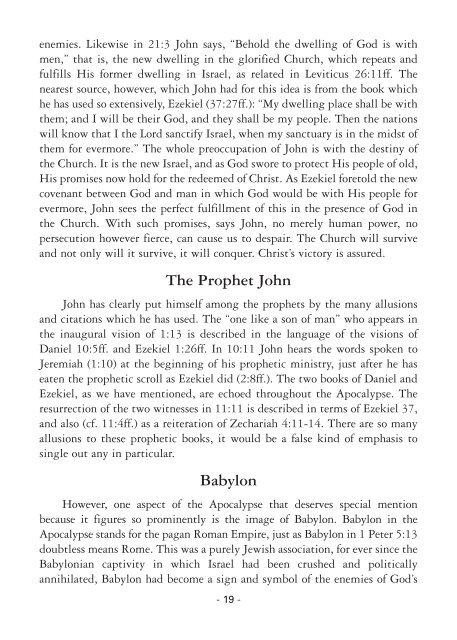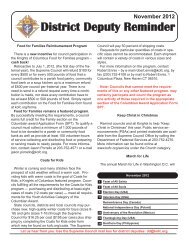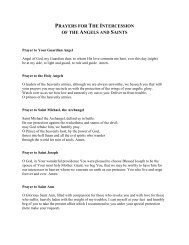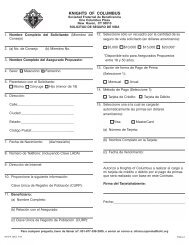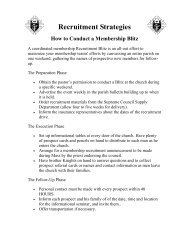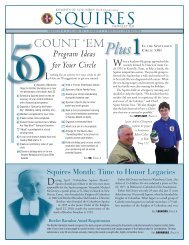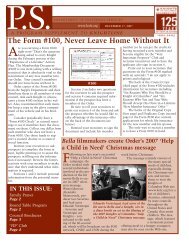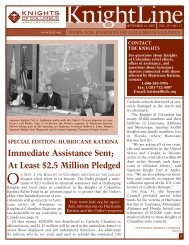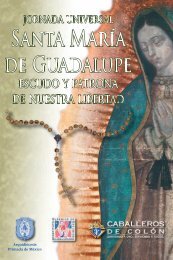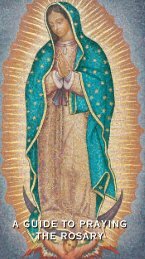Revelation: - Knights of Columbus, Supreme Council
Revelation: - Knights of Columbus, Supreme Council
Revelation: - Knights of Columbus, Supreme Council
Create successful ePaper yourself
Turn your PDF publications into a flip-book with our unique Google optimized e-Paper software.
enemies. Likewise in 21:3 John says, “Behold the dwelling <strong>of</strong> God is with<br />
men,” that is, the new dwelling in the glorified Church, which repeats and<br />
fulfills His former dwelling in Israel, as related in Leviticus 26:11ff. The<br />
nearest source, however, which John had for this idea is from the book which<br />
he has used so extensively, Ezekiel (37:27ff.): “My dwelling place shall be with<br />
them; and I will be their God, and they shall be my people. Then the nations<br />
will know that I the Lord sanctify Israel, when my sanctuary is in the midst <strong>of</strong><br />
them for evermore.” The whole pre occupation <strong>of</strong> John is with the destiny <strong>of</strong><br />
the Church. It is the new Israel, and as God swore to protect His people <strong>of</strong> old,<br />
His promises now hold for the redeemed <strong>of</strong> Christ. As Ezekiel foretold the new<br />
covenant between God and man in which God would be with His people for<br />
evermore, John sees the perfect fulfillment <strong>of</strong> this in the presence <strong>of</strong> God in<br />
the Church. With such promises, says John, no merely human power, no<br />
persecution however fierce, can cause us to despair. The Church will survive<br />
and not only will it survive, it will conquer. Christ’s victory is assured.<br />
The Prophet John<br />
John has clearly put himself among the prophets by the many allusions<br />
and citations which he has used. The “one like a son <strong>of</strong> man” who appears in<br />
the inaugural vision <strong>of</strong> 1:13 is described in the language <strong>of</strong> the visions <strong>of</strong><br />
Daniel 10:5ff. and Ezekiel 1:26ff. In 10:11 John hears the words spoken to<br />
Jeremiah (1:10) at the beginning <strong>of</strong> his prophetic ministry, just after he has<br />
eaten the prophetic scroll as Ezekiel did (2:8ff.). The two books <strong>of</strong> Daniel and<br />
Ezekiel, as we have mentioned, are echoed throughout the Apocalypse. The<br />
resurrection <strong>of</strong> the two witnesses in 11:11 is de scribed in terms <strong>of</strong> Ezekiel 37,<br />
and also (cf. 11:4ff.) as a reiteration <strong>of</strong> Zechariah 4:11-14. There are so many<br />
allusions to these prophetic books, it would be a false kind <strong>of</strong> emphasis to<br />
single out any in par ticular.<br />
Babylon<br />
However, one aspect <strong>of</strong> the Apocalypse that deserves special mention<br />
because it figures so prom inently is the image <strong>of</strong> Babylon. Babylon in the<br />
Apocalypse stands for the pagan Roman Empire, just as Babylon in 1 Peter 5:13<br />
doubtless means Rome. This was a purely Jewish association, for ever since the<br />
Babylonian captivity in which Israel had been crushed and politically<br />
annihilated, Babylon had be come a sign and symbol <strong>of</strong> the enemies <strong>of</strong> God’s<br />
- 19 -


